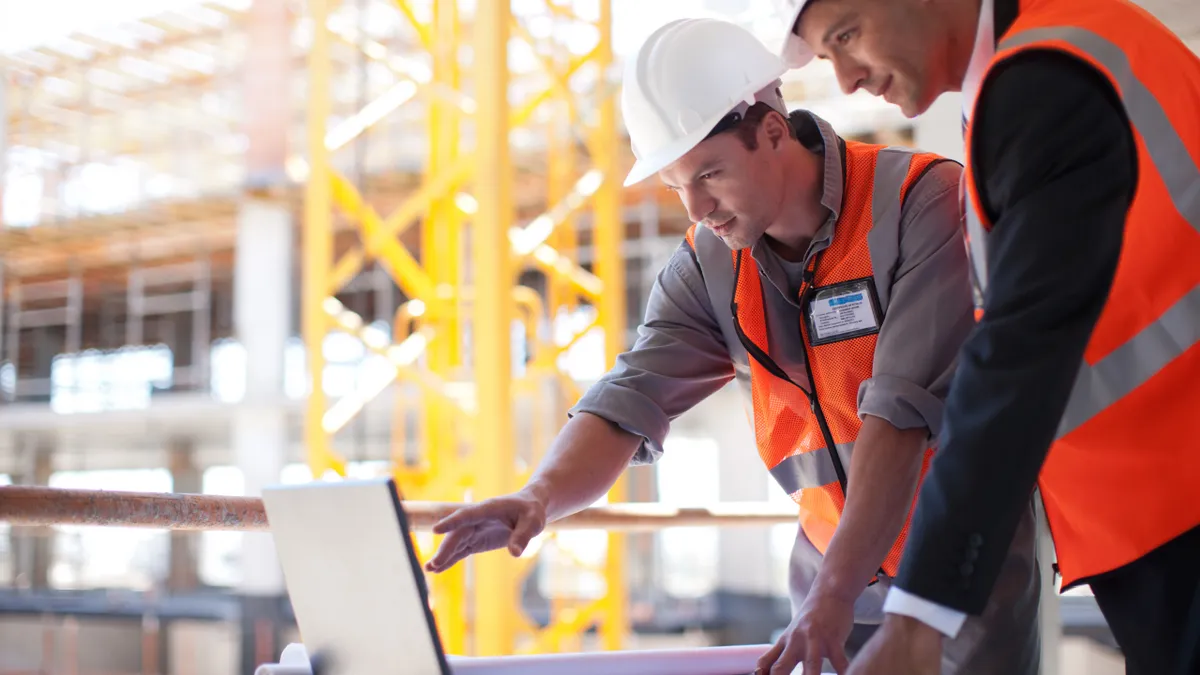Coronavirus-related shutdowns required contractors to scramble to find new ways to protect workers and monitor jobsite progress while maintaining social distancing.
Massachusetts-based Consigli Construction turned to image capturing tech like Matterport’s cloud-based platform, which allows for photographs of a site to be stitched together for up-to-date virtual walkthroughs; StructionSite, which uses 360-degree photos to document as-built projects; and aerial drone capture for documenting jobsites and scanning the site for 3D drawings.
Here, Jack Moran, director of VDC services for Consigli, shares with Construction Dive how the company used previously adopted technologies in the face of the pandemic, and what he thinks will be its long-term impact on construction.
This interview has been edited for brevity and clarity.
Can you share specifics on how Consigli uses reality capture tools?
JACK MORAN: These are tools that are about documenting project sites. We've been using those for quite a while and then we have adapted them for use during the pandemic.
We take thousands of photos of our jobs and they've been dumped into folders. So, we adopted StructionSite’s automated jobsite documentation, for example, which is a cloud-based hosting program. Instead of the photos being in folders, they're pinned to drawings, most typically floor plans. So, I go to the drawings and I say, "Okay, I want to look at the photo that I took in this mechanical room or this office." And you just go in, there's a pin for every location.
I can take a photo today [and] I can go back next week or next month or whatever the frequency is and append an updated photo. So, it creates a timeline we can quickly use to go back and say, "Here was the site today. What did it look like last month?" I can even pull them up side by side. It's a good way to document and track progress on jobs. It's also great because it's a deliverable at the end. We can download those drawings and the pins and the photos that are linked to them all come with it.
What are some challenges you’ve faced during COVID and how has tech has helped you overcome them?
MORAN: Construction is not something you do virtually. It's people in the field building things. It requires a steady stream of people going to and from the site. So, how do we kind of determine who absolutely has to be [onsite]? The challenge was balancing that need to keep eyes on the site, but less feet on the site. In some cases we've even used [image capture tech] as our building inspectors so that they could kind of get a preview of what the job looks like.
That was key to making people feel comfortable; that the project was progressing. In Boston we had a number of jobs that were shut down in the city. We had to mobilize pretty quickly to document what the jobsites looked like that day. We had three days or four days to make the sites safe. So, we needed to kind of document the project completely. Some of our owners knew exactly where things were when we stopped too so that we would be able to protect ourselves insurance-wise, if there was damage or something that was totally broken or stolen.
How do you see the pandemic changing the landscape of tech use and adoption on construction sites and in offices going forward?
MORAN: I think that's the silver lining, to be so bold as to say there's a positive thing going on here. Sometimes when things like this happen, it spurs kind of a ramp up of new ideas and technologies. Even things like Zoom and Microsoft Teams had to really push their tools because we all started using online meetings.
Online, real-time collaborative technology is going to be critical going forward. I think that we've learned that there's some things that have actually been better for us. I don't have to fly down to Washington every other week for meetings because the online collaborative tools have just gotten better even in a short amount of time.
We have been looking at things like artificial intelligence and robotics for a while. We've been asking questions. Are there other activities that can be made more efficient? Are there activities that can be done more safely by robots or other kinds of enhancements?
We invested in exoskeletons, for example. How do we reduce fatigue and repetitive stress injuries? That's an example of technologies adapting for safety. How do we use AI to track progress so we can respond? We can kind of monitor projects without having to go every day physically being onsite.
Our philosophy on technology set us up to adapt. We have always taken the approach that every time we look at a technology we look at it through the lens of, "Is it going to help us build more efficiently, more safely, provide higher quality experience for our owners?" So, that philosophy helped us to very quickly adapt technologies that we already had to the situation because we always think of them in a very practical sense.






















